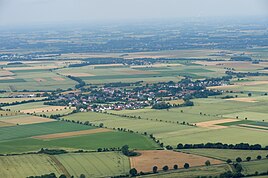Altengeseke
|
Altengeseke
Municipality of Anröchte
|
|
|---|---|
| Coordinates: 51 ° 33 ′ 23 " N , 8 ° 14 ′ 41" E | |
| Height : | 166 m above sea level NN |
| Area : | 9.46 km² |
| Residents : | 855 (Nov. 1, 2018) |
| Population density : | 90 inhabitants / km² |
| Incorporation : | 1st January 1975 |
| Postal code : | 59609 |
| Area code : | 02927 |
|
View of Altengeseke
|
|
Altengeseke is a district of the municipality of Anröchte in the Soest district in North Rhine-Westphalia , Germany . The mayor is Thomas Gerwin.
history
The first written mention of the place Altengeseke can be found in a deed of donation from Ludwig the Pious from the year 833. Count Ricdag receives 5 hooves in "Geiske". Ampen was also mentioned as Anadopa and the loach, only 6 km away, as Ismerleke.
But Geseke also claims this document as the first mention. On the one hand, the location on Hellweg as it is for Ampen and Schmerlecke speaks for Geseke as the subject of the document. On the other hand, the distances between the villages: Ampen ↔ Schmerlecke (15 km), Schmerlecke ↔ Geseke (19 km). This also proves a Carolingian royal estate that only existed in Geseke, but not in Altengeseke. Likewise, the spelling "Geiske", which does not differ from the later spellings of Altengeseke in the 11th / 12th Century can be reconciled, another indication of the city of Geseke. Furthermore, there is only archaeological evidence of settlement in Geseke in the 9th century, in Altengeseke the archaeological evidence of settlement does not begin until the 11th century. In addition, Ricdag 822 was already active in Bönninghausen, which is only a few kilometers from the city center of Geseke.
The village has had the prefix Alten since around 1238 . Altengeseke was under the influence of the Gogericht Erwitte within the Archdiocese of Cologne until 1822 .
The place was the seat of a ministerial family named Veschen (also Jeschen or Geischen) of the Counts of Arnsberg. The family was mentioned in a document between 1238 and 1484. The family then died out, the shared goods went to the Schlinkwurm (Kettler) and von Wrede families. Nikolauskirche was built between 1752 and 1756 and the tower was renewed in 1798. During the Soest feud in 1445, the village was badly sacked and in the Thirty Years' War in 1622 by the Brunswick people was reduced to rubble. The residents were looted several times from 1631 to 1638. The plague struck the village in 1636. The population became impoverished.
During the municipal reorganization , the formerly independent municipality was in office Anröchte on 1 January 1975 following Anröchte incorporated and has since become one of the ten villages of the newly formed congregation.
economy
The village is predominantly agricultural, numerous old quarry stone - brick and half-timbered buildings characterize the townscape. New development areas from different epochs encircle the town center . The newly added buildings differ greatly in terms of roof, material and color design. They form a strong contrast to the old village structure. There are also a number of farms that are no longer managed and have been converted, such as the nostalgic Café Ruppertz. There are seven full-time and eight agricultural part-time businesses. A total of 13 different craft and catering businesses offer around 85 full-time jobs.
Buildings
The most striking building is the baroque parish church of St. Nikolaus (Altengeseke) , built in 1752 . The center of the village community is the shooting hall, built in 1922, which was expanded in 1973 and from 1995 to 1999. The financial situation of the owner (Schützenbruderschaft St. Nikolai) was particularly badly affected by the construction work during the 1990s. In the local area there is a war memorial and some wayside shrines.
Educational and educational institutions
A community kindergarten with 25 places is maintained in the village . Primary school students are assigned to the primary school in Anröchte. Secondary schools are located in Erwitte and Anröchte.
Web links
- Description and photos
- Altengeseke in the Westphalia Culture Atlas
Individual evidence
- ↑ http://www.regesta-imperii.de/regesten/1-0-0-karolinger/nr/0833-04-01_1_0_1_1_0_1977_920.html?tx_hisodat_sources
- ↑ Albert Ludorff : The architectural and art monuments of Westphalia, published by the Provincial Association of the Province of Westphalia District Lippstadt, 1905, page 9
- ^ Federal Statistical Office (ed.): Historical municipality directory for the Federal Republic of Germany. Name, border and key number changes in municipalities, counties and administrative districts from May 27, 1970 to December 31, 1982 . W. Kohlhammer, Stuttgart / Mainz 1983, ISBN 3-17-003263-1 , p. 334 .
- ↑ Description of the place
- ↑ Altengeseke ( Memento of October 18, 2011 in the Internet Archive ) (PDF; 714 kB)



